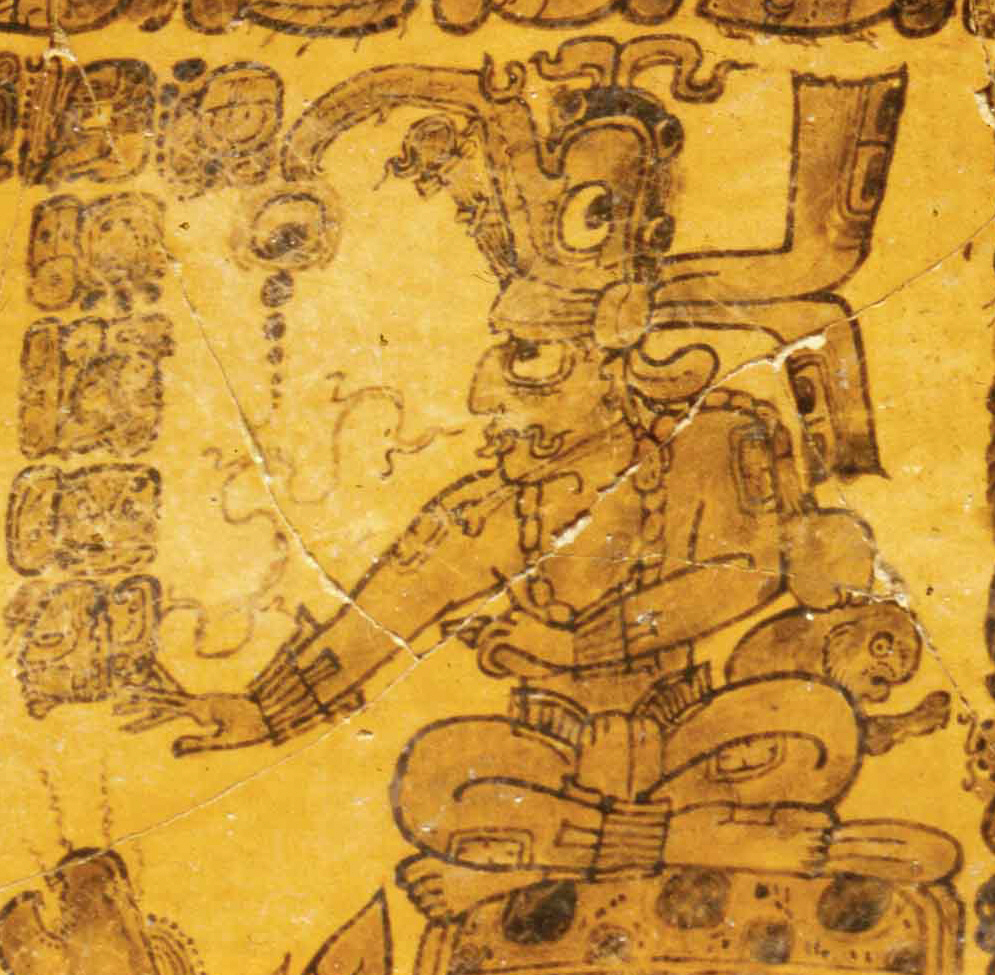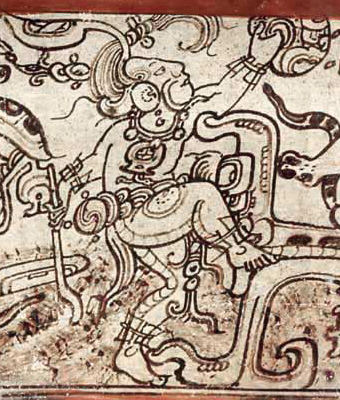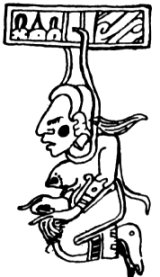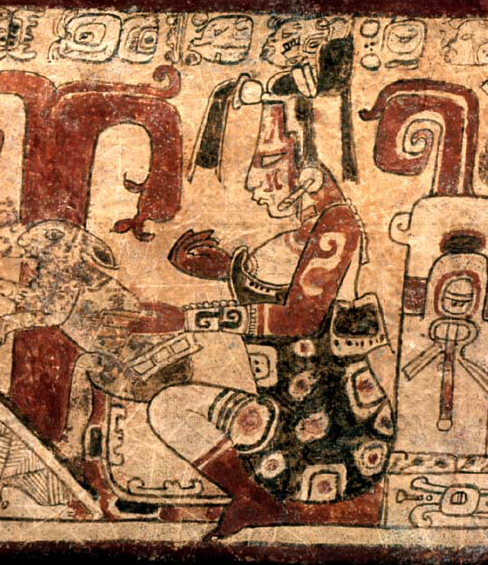 |
| Good ol' cross-eyed sun gods with fascinators! #2 below. |
Enjoy that last ranking? If not… too bad! Because it’s going to keep going. I’m ranking the 50 most interesting gods and supernatural beings in Maya mythology. Now we get to the most interesting of the interesting.
For the bottom half, I’m sure you noticed that some of the entries were pretty brief. As we get further down in the top half, that won’t be the case. More interesting gods and beings have more interesting things to talk about! Some of these will get wordy. Whatever.
Some quick reminders from Part I:
- There are obviously more than 50 Maya gods and supernatural beings. I’m simply picking the ones that I feel to be the cream of the (usually blood soaked, murderous) crop.
- Maya beliefs continue to this day, and there are newer gods (or older gods that take on newer attributes and stories, based on how they were syncretized by Christians and/or are used in “New Age” religions). For the most part, I will try to avoid any stories/gods that aren’t part of the Classic (200–1000 CE), Post-Classic (1000–1539 CE), or Contact Periods (1511–1697). That being said, it’s sometimes hard to really know what the old school beliefs were (since they weren’t written down), so some newer stuff might bleed in.
And some new info for Part II, about the “Letter Gods” (or “Alphabet Gods”):
- As these gods are more interesting, they’re also more important. The more important gods were referenced often in Maya stories, and instead of simply being talked about by the Maya to Christians writing down stories in books, these gods often featured prominently in ancient art, sculpture, etc.
- Early on, people tried to figure out who all these gods on the side of ancient temples and stones were, but couldn’t. So the “experts” gave them names, like “God A,” “God B,” and so on.
- After those gods were originally given those generic names, more recent experts have finally figured out the names for a lot of those gods (or at least taken good guesses as to who they might be).
- Some of the Gods in Part I were also alphabet gods, but if they were, I didn’t really mention that because those gods were only sort of interesting. Some people think Ah Puch was God A, but nobody is sure. As we cover the top gods, I felt it was more important to name their lettering, if they have it and/or the gods are still well-known by that lettering.
Now, without further ado, the top 25:
25. Hapikern
The World Serpent. Perpetually at war with Nohochacyum, a god of creation and destruction (it’s good to be a god of both those things at once, as it leads to job security), and is fated to be destroyed by that god in a final battle (which sucks for it).
 |
| It's your friendly Popol Vuh family tree! Also... Ballplayer! |
24. Hun-Hunahpu
Father of the hero twins, beheaded in Xibalba by Hun-Came and Vucub-Caquix (I believe the specific death gods who murder him might depend on the version of the story). Setting up the revenge epic. Also the father of the Howler Monkey Twins. After his murder, he may have been reborn as a maize deity (although there is debate). As alluded to in Part I, after he was murdered… his undead zombie sperm also made its way onto Xquic. So he’s got some major “Osiris” vibes going on here for being a posthumous father god with magic death sperm.
23. Goddess I (“White Goddess”)
Like the Moon Goddess that I’ll talk about soon, this poor goddess has lost her specific name, other than that she might be “the White Goddess” in contract to Ix Chel’s (also below) possible moniker of “Red Goddess.” She is seen to be the “terrestrial” counterpart to the Moon Goddess. If the Moon Goddess and Ix Chel are the same, that would make the comparison between Ix Chel and Goddess I as being the counterpart Red and White Goddesses all the more fitting and logical.
22. Acan
God of wine and intoxication. Cool! Every religion has one of these because every religion needs one of these.
 |
| Let's make some RAIN wit dat lightning axe! |
21. Chaac (God B)
Rain god who owns a lightning axe (how fucking cool is that?). He hits clouds and makes thunder and lightning. Said to be the enemy of Camazotz. Oh, Camazotz is going to be fun!
20. Chin
God of homosexuality! Especially associated with pederast activities. So yeah, the Greeks weren’t alone in that boy-loving stuff. Nothing in a more detailed description about this god will read as politically correct these days.
19. Och-Kan
The “Vision Serpent,” associated with Maya bloodletting rituals, where participants would experience visions in which they communicated with the ancestors or gods. Ol’ Serpent boy did that for them. A direct link between man and their ancestors / the spiritual realm.
18. Tonsured Maize God
Maize was important to the Mayans, and there were a number of different maize diety myths, which I’m sort of summing up all together under the indemnity of “the Tonsured Maize God.” I’m not sure I can give a more specific name for this god-o-corn, because there were so many different ones. As I’ve noted elsewhere, the father of the hero twins, Hun-Hunahpu, might be the (or “a”) maize god. The maize god is also referred to by names including various forms like ah mun (tender green shoot), zac uac nal (white six new corn), uac chuaac nal (six tall new corn), "ixim" (maize grains), and so on.
 |
| Pretty hot goddess, huh? |
17. Moon Goddess
If she is not Ix Chel (see separate ranking), whatever the Classic Maya Moon Goddess was named, it has been lost to history. The moon was sometimes thought to represent the stages of a woman’s life. She is associated with sexuality and procreation, fertility and growth, not only of human beings, but also of plants and crops. Ironically, she’s also associated with the opposite of fertility and growth – e.g. she is the goddess of disease. Also associated with water (wells, rainfall, etc).
16. God L
A jaguar god of evening and darkness, yet his name is lost to history (some sources say God L is “Voton,” but Voton is almost certainly a post-Christian invention and not a true Maya god near to any original form). He is a god of wealth, magic, shamanism, and war. In addition to jaguar attributes, he is also depicted with some owl attributes. In the Popol Vuh, he is one of the lords of the underworld. It’s possible that the aspects of the “Night Sun” associated with the Jaguar God of the Underworld / Jaguar God of Terrestrial Fire might mean that he is God L. If so, that would invalidate my classification of that god as the same as Kinich Ahau (see below), as Kinich Ahau is already God G. Unless, as explained in the ranking for Kinich Ahau, God G simply transforms into God L at night.
15. Ek Chuaj (God M)
Fun fact! “Ek” means “black,” so any gods you find with “ek” will basically refer to that. Ek Chuaj was a patron god of both warriors and merchants, although more commonly associated with the merchant side of those two choices. Depicted with dark skin (hence Ek), circles around his eyes, a scorpion tale (he’s sometimes called “Black Scorpion”), and carrying a bag over his shoulder. What’s in the bag? Probably CHOCOLATE! Ek Chuaj was also the god of cacao (again!), which was basically used as currency in Mayan society.
14. Itzamna (God D)
Creator and sky deity. Creator of maize, cacao (again!), writing, calendars and medicine. His name is a bit of a mystery, though it might mean something along the lines of “wizard.” He’s a healer who can raise the dead (although he may have taken on more of his Jesus-ey attributes only after the coming of the Spaniards). Often depicted as an old man, dressed up like a priest. Sometimes represented as a bird, or maybe even the older form of the Tonsured Maize God.
 |
| Call 1-800-273-8255 |
13. Ixtab
Appearing in the Dresden Codex apparently as the Goddess of suicide, she is represented with a rope placed around her neck. Similar to the Grim Reaper (or Psychopomps from Greek Myth), she is said to guide the souls of the recently dead to the afterlife. Alas, there are some theories that her Dresden Codex depiction might not even depict her, and that it’s all a big mix-up. If that’s the case, then nobody quite knows what Ixtab was all about (references to her in the Chilam Balam are vague) or how else she might be depicted. When she is mentioned, it is in the context of chaos, suffering, and hanging, and her name seems to mean “woman who uses rope.” If the specific suicide connotations are a bad reading, she is probably still all about that hanging and death stuff. Who knows? Maybe she’s supposed to be the goddess of auto-erotic asphyxiation.
12. Nohochacyum
A creator/destroyer god, perhaps the brother of death god Ah Cizin / Kisin. Perpetually at war with Hapikern, who he will kill one day in a final battle (by making him wrap around himself and suffocate). Some versions of the story say that Nohochacyum will destroy all life in that battle. So we have that to look forward to. What fun would religion be without a little end times, be it Ragnarok, Christian eschatology, or a battle against a giant world snake?
11. Vucub Caquix
“Seven Macaw,” a bird demon (or god) who is one of the primary villains that is eventually defeated by the Hero Twins in the Popol Vuh. His name might represent the same seven stars that we now thing of as the big dipper, though I suppose Mayans thought it was a macaw.
10. Buluc Chabtan (God F)
God of war, violence, death, and sacrifice. Is this who they were going to sacrifice Jaguar Paw to in
Apocalypto? Maybe. I dunno. He’s sometimes depicted as setting people on fire, and in the Dresden Codices is portrayed as being eaten by maggots. So this guy is just fun all around. Ares wishes that he was as badass of a war god as this guy. Welcome to the Top 10, baby!!! Oh, he's also the god of gambling too. Which is basically the same thing as war.
Boss.
8. Qʼuqʼumatz (Tie)
There is no #9. There are a thousand million variations on how to spell this, so I won’t say them all, other than to note that “Gucumatz” is another common form. He’s the feathered serpent deity of the Popol Vuh creation epic, and is said to have created humanity together with Tepeu. If “feathered serpent” is ringing a bell for you, IT SHOULD! Qʼuqʼumatz is the (rough) equivalent of the Aztec god Quetzalcoatl (I guess Quetzalcoatl had better PR guys), and another Maya god figure, Kukulkan. Also the god of law, agriculture, literacy, the arts, medicine, architecture, construction, hunting, and fishing. Basically “civilization,” if you will. The god of civilization. Pretty important god!
 |
| Feathery snake boi. |
8. Kukulkan (Tie)
“Feathered Serpent,” and therefore again closely related to Qʼuqʼumatz and Quetzalcoatl. The name is cool as hell, and depictions of the god run along the stairs of the very famous Chichen Itza. Alas, little much else survives about the myths of this god. Perhaps we can assume his stories just assimilated into those of Qʼuqʼumatz. There is no way I can give these two different rankings, so I’ll rank both of these at #8.
7. Camazotz
You may recognize this word as the name of the evil planet in
A Wrinkle in Time. Well, what the word really translates to is “Death Bat!” HELL YEAH! A7X, BITCHES! But more seriously Death Bat was sort of man-bat god, which sort of makes him the Mayan version of a vampire. Or Batman, to state the obvious. Another god featured heavily in Popol Vuh, and resident of the underworld of Xibalba. There is a different god with a nearly identical name, Camalotz, who is said to have beheaded everyone in the world after the second time life was created. I didn’t give Camalotz his own entry, but I figured that was worth nothing here, because that’s pretty cool too.
6. Hun-Came and Vucub-Came
“One Death” and “Seven Death.” I’ve pulled out these two from the rest of the assorted minor death gods because they were not minor! They are the principle gods of Xibalba and their story is cool. These were prime assholes who, along with Vucub-Caquix, murdered Hun Hunahpu, the father of the Hero Twins. That sets the whole hero’s journey for the twins in motion, and makes up a good chunk of the text of the Popol Vuh. Obviously, being the villains of the tale, the Hero Twins get revenge and kill them.
 |
| The Maya invented tentacle porn, I guess. |
5. Kʼawiil (God K, Bolon Tzʼakab)
Lightning god and harvest god. Cool. That’s multitasking in godly duties. Also associated with serpents and fertility (which makes sense for a harvest god). The “Bolon Tzʼakab” version of the names means “Innumerable Generations,” which is awesome. Post-Classic codices referred to him as “God K” for a long time (which was obviously never his actual name), but now we think his name was K’awiil, which is thought to mean “powerful one.” This is a pretty important and cool god. Given that's he's associated with serpents, he's sometimes depicted with a snake tail. Fertility + snake tail will obviously lead to some kinky art, as you cal tell from the picture on the right.
4. Huracan (U Kʼux Kaj)
U Kʼux Kaj means “Heart of Sky” (AWESOME name), though Huracan means “one legged” (slightly less awesome). God of wind, storm, fire and one of the supreme creators who participated in all three attempts at creating humanity. He also caused the Great Flood after the second generation of humans angered the gods. As you’d probably guess from just reading the word “Huracan,” yes, this god of wind, storms, destruction and floods is the origin for the word “hurricane” that we use today.
 |
| Regrettable ass tattoo from Acat? |
3. The Hero Twins, Hunahpu (God S) and Xbalanque (God CH)
I would write forever about the Hero Twins, since they are the main characters of Popol Vuh. The short version? They are twins that represent duality. Life and death, sky and earth, day and night, sun and moon, etc. They are summoned to Xibalba by the Lords of the Underworld, and go there to defeat the bad gods and avenge the murder of their father (and uncle). In the end, they are elevated to god status and become the sun and the moon. This is the super short version, everyone. I am cutting a lot of stuff out here. Hunahpu’s name is universally understood to mean “one blowgunner,” because he used a blowgun. Duh. “Hun” is also the name of a ton of gods (many who don’t make my rankings), and it means “one.” Which, I guess, is a pretty easy thing to name your first child. Xbalanque’s name is a bit more mysterious, as the “X” might come from “yax” (meaning blue-green, but usually referring to jade, which therefore also means “wealth” or “precious”). The “balan” part either means “hidden” or “jaguar,” and the “que” part means either “sun” or “deer.” Jaguar Sun? Precious Jaguar Sun? Hidden Sun? Precious Jaguar Deer? I dunno!”
2. Kinich Ahau (God G, Ahau-Kin) likely also the Jaguar God of the Underworld
Kinich is thought to mean “sun-eyed” or “sun,” and Ahau is a title used meaning something along the lines of “king” or “lord” or “god” (Ahau/Ajaw was a general royal title used during the classic period). So this sun god’s name might literally be SUN GOD. He has a very specific description, that usually involves him being a middle-aged man with a curved nose, large crossed eyes, and a filed incisor in his upper row of teeth. Although the Hero Twin myth ends with them becoming the Sun and Moon, no link between Ahau-Kin and the heroes ever seems to have been made. Kinich Ahau / Ahau-Kin might be one and the same as the Jaguar God of the Underworld, as both are depicted with very similar features (large eyes and filed incisors). The Jaguar God of the Underworld is also sometimes referred to with the “k’in” infix, specifically referring to the sun. If they are the same (and I like to think they are), the Jaguar God is also therefore “The Night Sun” or the “Jaguar Sun,” and the form that Ahau-Kin takes during the nighttime after the sun sets below (and hence enters the underworld). He is also called “the Jaguar God of Terrestrial Fire,” and represents a nocturnal sun (subterranean fire). Ahau-Kin turning into the Jaguar God of the Underworld, who travels from west to east, also makes sense... because then that explains how the sun is in the east again in the next morning. All those things combined = cool. But then again, sun gods are usually awesome.
1. Ix Chel (Goddess O)
Jaguar goddess of midwifery, childbirth, and medicine. She was greatly venerated by women, especially those trying to get pregnant. Sometimes depicted as elderly with jaguar ears (in more modern times, she’s depicted as young and hot). The meaning of her name is unknown, with theories ranging from “Lady Rainbow” to “Red Goddess.” She may associated with rain, and also may be the consort of Chaac. Sometimes associated with war and depicted in ancient images with claws, surrounded by bones. Since the Moon was associated with the stages in a woman’s like in Maya mythology, the Maya Moon Goddess, when depicted in her elderly form, might also be the same goddess as Ix Chel. The jaguar was also associated with the moon and the night sky, depending on the myth, and the Moon Goddess also shares some of Ix Chel’s attributes related to fertility and medicine. So it’s not without logic that Ix Chel might be the (or one of the) missing names for the Moon Goddess. At the very least, Ix Chel is probably a later version of the Classic-era Moon Goddess. Still, there is enough confusion so that I have two entries, one specifically for Ix Chel, and the other for the nameless Moon Goddess. Either way, she’s cool as hell. Ix Chel doesn’t have to also be the Moon Goddess to make her cool. She’s already a jaguar goddess of birth, medicine and war who likes to surround herself with the bones of her enemies. Stay clear from this lady!




.jpg/1280px-Swiss_army_knife_open_20050612_(cropped).jpg)


.jpg)




.svg/1280px-Cyrillic_letter_De_(v2).svg.png)




.jpg/1280px-Ebola_illustration-_safe_burial_(15573264517).jpg)

.png)











_01.jpg/800px-Estela_de_Madrid_(Museo_de_Am%C3%A9rica)_01.jpg)
.jpg)

